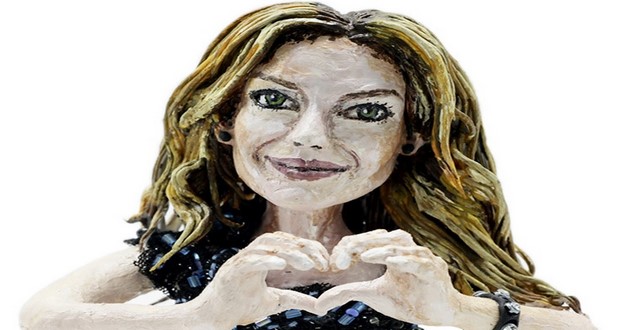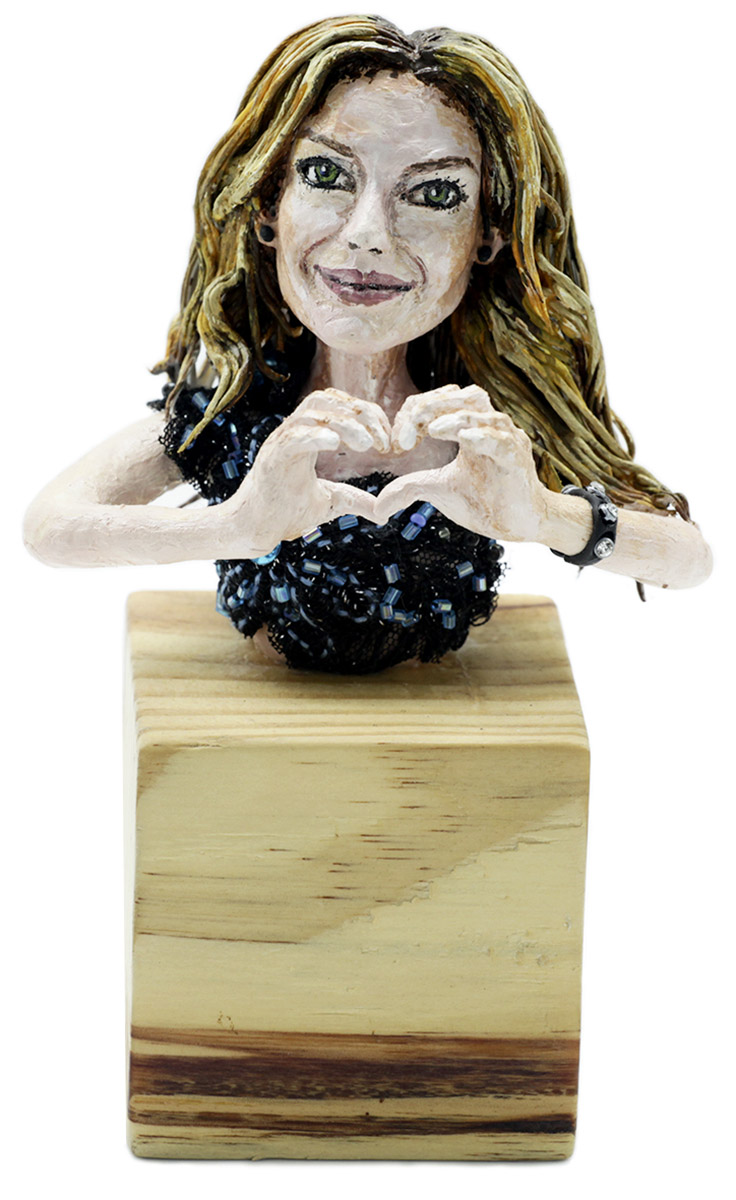“Paper people ", Madalena Marques, occupies the room MAS / Metro Tiradentes with pieces that represent the passion of the artist's portrait art, presenting a wide range of human figures known to the general public, in addition to historical and constructive references that address the most different areas of knowledge
The Museu de Arte Sacra de São Paulo – MAS / SP, institution of the Department of Culture and Economy of the State of São Paulo Creative, inaugurates “Paper People”, visual artist Madalena Marques, curated by Ana Claudia Cermaria and John Paul Berto. The individual features 64 paper mache sculptures – other materials are also used in the production of parts, such as wool, metal, and fabric jeweled -, which represent the passion of the artist's portrait art, bringing a wide range of human figures known to the general public, in addition to historical and constructive references that address the most different areas of knowledge.
By using the unique materials, Madalena Marques transits the art, by cultural events and art history, in a show that seeks to bring viewers the elements inherent to the creative universe of the artist, Experimental marked by, the challenges and knowledge grounded in research, that guides its activities and artistic production. In "Paper People”, the visitor is faced sculptures of characters as the writer and poet Cora Coralina, actress Fernanda Montenegro, the singer, composer and visual artist Arnaldo Antunes, singers Elis Regina and Marisa Monte, Gisele Bündchen, the cartoonist and cartoonist Laerte, the stylist Ronaldo Fraga, among many other personalities. In his sayings: “Make a miniature someone I chose because I like my food is energy soul, is my way to express my love for this universe ... I think this is the role of my art, bring joy to the hearts of the beholder”.
In addition to this selection of Brazilian famous people, the audience is taken on a tour through the history of Western art, National and international, through the Renaissance to the Brazilian Modernism. Nine female characters were chosen by Madalena Marques to strengthen the role of women in the art world, be represented as or as a producer, taking into account also the wealth of details, driving element for the creative mind of the artist. Here, interpretations are displayed in iconic works such as the Mona Lisa, de Leonardo da Vinci, self-portraits "Red coat”, Tarsila do Amaral, “Thinking of Death”, Frida Kahlo, and the artist herself, among others.
From intensive research, each piece was produced by Madalena Marques in order to give life to completely two-dimensional sculptures. For this, featured live models, whose facial features were approaching the chosen figures. After the preparation stages of parts and painting, They were designed and produced the outfits, using tissues that, sometimes, They were worked imitating prints and other details. “I chose to represent the human figure for several reasons. The expression of the eyes is a vibrant thing, each being is unique and reproduce these expressions is like shooting their souls”, explains the artist.
The history of paper mache intersects with the history of the paper itself, its main raw material. Its use dates back to the second century A.C.. by Chinese. in the west, on the other hand, the French were responsible for the spread of technical. In the eighteenth century, Also the Germans started to use paper mache to give more strength to dolls and, in the mid-nineteenth century, It came to be used to make dolls with articulated bodies. “In the specific field of sculptures, the invoice works on paper mache set a specific type, said light sculptures, given the speed of production and the economy of the materials used, associated with the finish was similar to wood. This strongly developed during the periods of the Renaissance and the Baroque Italian and Spanish, between the sixteenth and eighteenth centuries, time marked by the popular technique”, comment shows the Trustees of. Its use is also linked to the production of ephemeral works for celebrations or other acts and mold works that would later be made more noble materials, like bronze.
| Exhibition: “Paper People” |
| Artist: Madalena Marques |
| Curated By: Ana Claudia Cermaria and John Paul Berto |
| Opening: 6 April 2019, Saturday, to 11 hours |
| Period: 7 April to 3 June 2019 |
| Local: Room MAS / Metro Tiradentes – www.museuartesacra.org.br |
| Tiradentes subway station – São Paulo - SP |
| Tel.: (11) 3326-5393 - scheduling / educational for guided tours |
| Timetables: Tuesday to Sunday, from 9 às 17h |
| Entrance: Free to Metro users |
| Number of works: 64 |
| Techniques: Sculptures in papier mache, Offer, metal, and fabric jeweled |
| Dimensions: varied |
.
Press:
Museu de Arte Sacra de São Paulo
Silvia Balady – silvia@balady.com.br / Zeca Florentino - zeca@balady.com.br
Tel.: (11) 3814-3382 | (11) 99117-7324
Department of Culture and Economy of the State of São Paulo Creative - Press office
Stephanie Gomes | (11) 3339-8243 | stgomes@sp.gov.br
Sign up to receive Event News
and the Universe of Arts first!
Madalena Marques (Uberlândia, MG – 1963)
Production in paper mache is vast, but it is in portraiture that it acquires great wealth and a highly innovative plastic result, the result of a course of study and experimentation. Single family, early he used creativity to invent their own puppets. With mother, He learned not only the techniques of embroidery, but to observe nature, your details and your wealth. He studied Fine Arts and worked as inker on a television station. In 1994, He moved to São Paulo, where married and their continued formation. His work with paper mache yet begun to 19 years; It resumed during childhood of his daughter and, finally, It gave rise to its miniature design national artists. Inspired by sacred works from the sixteenth to the eighteenth of imaginary light, united in their great detail sculptures, joining techniques and diverse materials, representing lightly the intense expressions of the human figure.
The museum
The Museu de Arte Sacra de São Paulo It is one of the most important institutions of its kind in the country. It is the result of an agreement signed between the State Government and Mitra Archdiocese of Sao Paulo, in 28 October 1969, and its installation date 28 June 1970. Since then, the Museu de Arte Sacra de São Paulo He came to occupy wing of the Monastery of Our Lady of the Immaculate Conception of Light, on Avenida Tiradentes, downtown São Paulo. The building is one of the most important monuments of colonial architecture São Paulo, built of rammed earth, rare remaining example in the city, last farm convent city. It was listed by the Historical and Artistic Heritage Institute National, in 1943, and the Council for the Defense of Heritage, Architectural artistic and the State of São Paulo, in 1979. It has much of its collection also listed by IPHAN, since 1969, whose priceless heritage includes relics of stories in Brazil and worldwide. The Museu de Arte Sacra de São Paulo holds a vast collection of works created between centuries 16 and 20, counting with rare specimens and significant. There are more than 18 thousand items in the collection. The museum has works of recognized names, as Frei Agostinho da Piedade, Frei Agostinho de Jesus, Antonio Francisco Lisboa, the "Aleijadinho" and Benedito Calixto de Jesus. Noteworthy are also the collections of nativity scenes, silverware and jewelery, Lampadarios, furniture, altarpieces, altars, clothing, liturgical books and numismatic.
OF SACRED ART MUSEUM SAO PAULO - MAS / SP
Chairman of the Board of Directors – José Roberto Marcelino
CEO – José Carlos Marcal de Barros
Director of Planning and Management – Luiz Henrique Neves Marcon
Technical director - Maria Inês Lopes Coutinho



